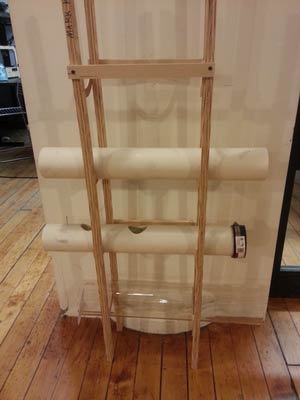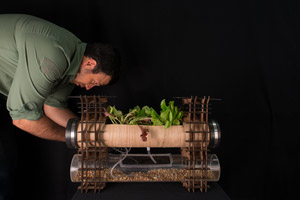Skills: Digital Fabrication | Illustrator | Urban Gardening | Solar | Circuit Design | Visual Design | Prototyping
Summary: Solar Powered Stackable Aquaponic Garden. A modular closed loop system used to grow plants utilizing the waste from the fish tank as fertilizer.
Project Background: Sustainable Energy Class Final Project. The challenge was to create a device that would perform a function without the use of batteries or plugging in to an outlet. Energy could only be derived from its users or the surrounding environment and energy usage in terms of input, storage, and output, with efficiencies at each stage. had to be quantified.
Team and your role: This was project was done individually.
The Work: There are multiple ways to harvest and produce energy (chemical, kinetic, solar, wind, etc...) Previously, I created a Microbial fuel cell (MFC) using bugs as fuel to power an analog clock. I wanted to try my hands on solar for this project. As a participant in Farm School and with some inspiration of Brita Riley's work on WindowFarms, I wanted to incorporate Urban Farming to my project. I decided to make a stackable solar powered aquaponic garden.
Urban Farming's popularity has grown and with people now more worried about the produce they consume, the ability to grow your own Non-GMO vegetables in a viable way has become attractive for people. Space is always a concern in urban areas, so my idea of creating a modular and stackable system was ideal.
Current aquaponic systems are large, industrial, fixed, and with little to no design aesthetics as you can witness from the images on the left. They are not modular and require a power source.
The aquaponic cycle is a closed loop system. You start off with fish that produce fish waste which is pumped to the plants as a fertilizer. The plants in turn filter the "waste water" and return clean water back to the fish, without the use of a filter pump.
My first Iteration was a disaster! It was non-modular with an articulated arm that contained solar panels. As a first prototype, it was not visually appealing and hard to transport. I had to make it stackable and easy for people to disassemble when needed. Making it modular was a priority. My initial desire was to make this into a kit anyone could build. For fast prototyping, I am a fan of using masonite. It cuts well and clean in a laser cutter and provides the structural integrity I needed for the base. The materials I used were:
- 3 Goldfish
- 4.5 inch diameter Acrylic tube for the fish
- 4.5 inch diameter PVC pipe
- 1/8 inch Masonite board
- Caps for the PVC pipe
- Clay Pellets
- Rocks for the fish tank
- 2 solar panels from Adafruit.com - Each panel is 6 Volts
- Peristaltic Liquid Pump with Silicone Tubing
- Clear tubing
- Silicon to cap the drip from the plant tube and the spigot
- Spigot
- Wire
- Solar Engine circuit
- A roll of Wood Veneer
- Contact Cement
Success Metrics: The difficulty I encountered was in creating the circuit needed to maintain the pump functional. Although the solar panel, hooked up in series, provided a bit over 12 volts at 250 Milliamps, I needed a higher amount of starting current to get the pump working. There were two ways to doing this. Creating a solar engine circuit that would charge up some capacitors or using a diode with a 6 volt battery attached to the the solar panel to get the pump started. The Open Circuit Voltage measured at 10.6V and Short Circuit Current at 0.45A, I got about 3.65 W in direct sunlight from the solar panel.
Below is the video of the pump working alongside the circuit diagram for the solar engine. Lettuce was grown and maintained in this enclosure.
What You Would Have Done Differently: I was happy with the end result but there definitely could have been improvements in the design and material choices. I would have added copper tape to minimize the usage of wire from the solar panel to the pump. I would have also added a carbon filter to fully filter anything the plants were unable to filter back down to the fish.









